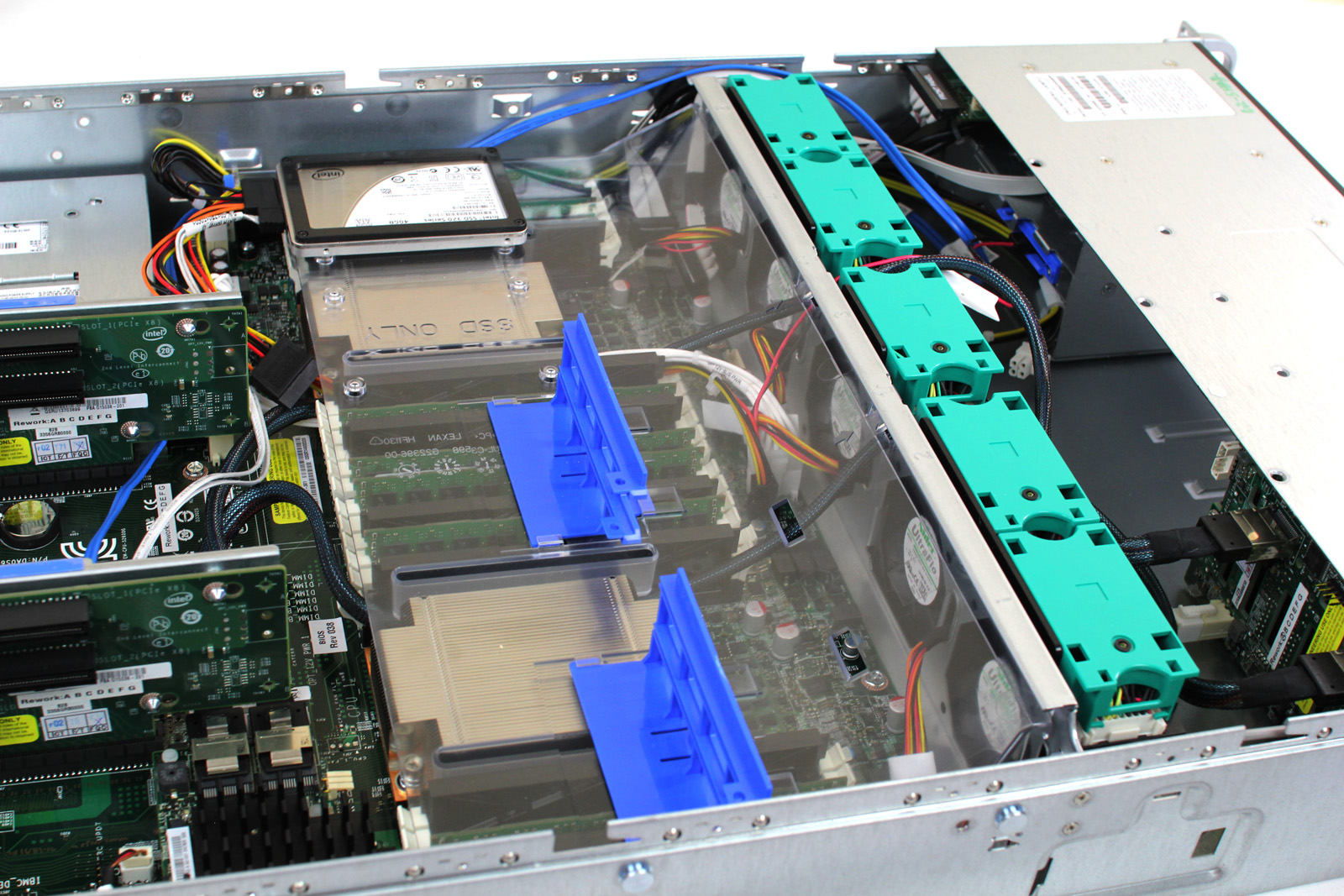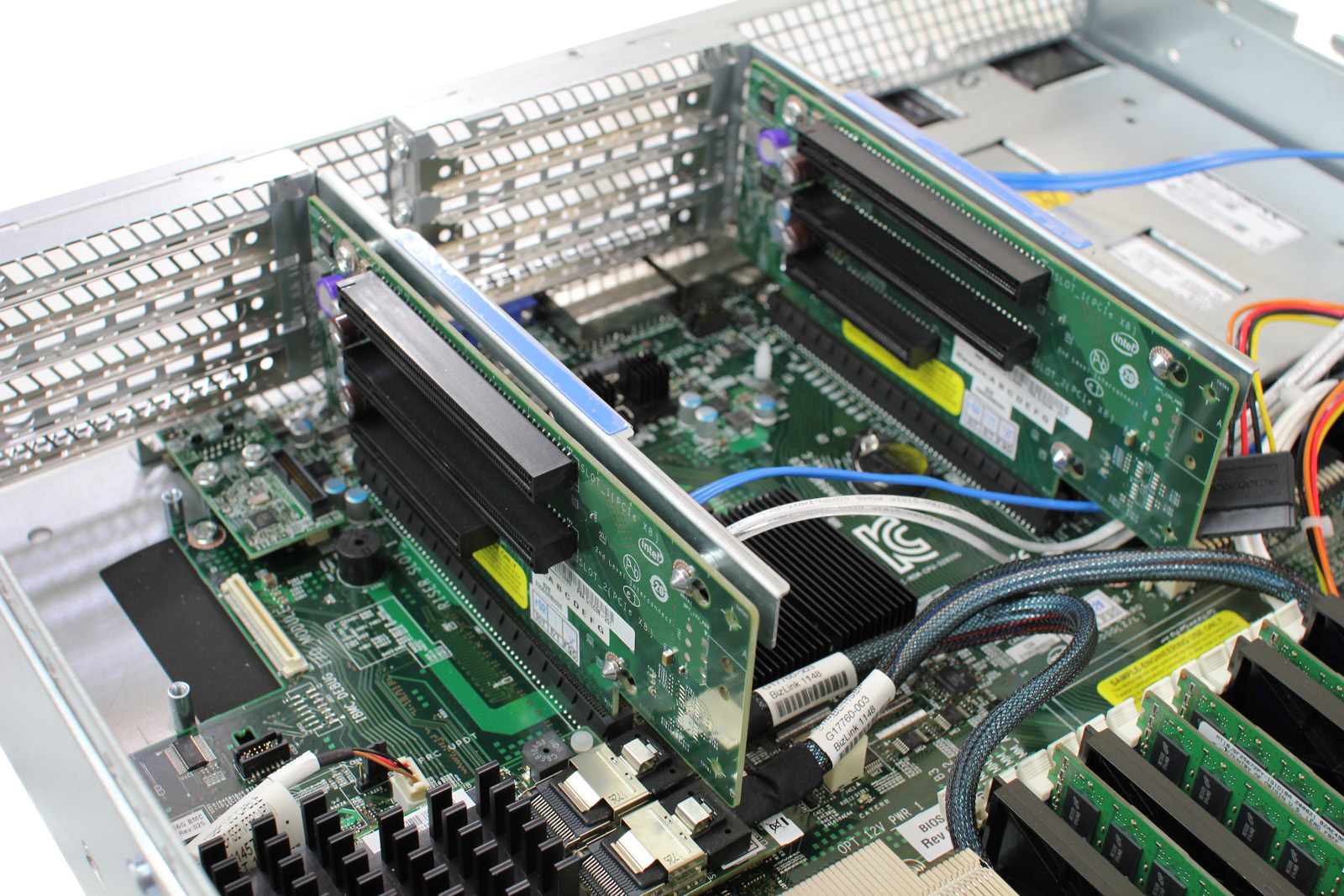Three Xeon E5 Server Systems From Intel, Tyan, And Supermicro
After taking a first look at Intel's Xeon E5 processors, we wanted to round up a handful of dual-socket barebones platforms to see which vendor sells the best match for Sandy Bridge-EP-based chips. Intel, Supermicro, and Tyan are here to represent.
Intel R2208GZ4GC: Layout And Overview, Continued
Expansion slots are enabled through two riser cards, which allow for up to six single-slot add-in devices in total. Intel also offers its own proprietary network and RAID cards. You can see the spot at the bottom-right corner of the rear panel that takes NICs, such as a dual-SFP+ X540-based Intel 10 GbE upgrade. Intel armed our machine with a dual-port 10 GbE controller, but we pulled it out to maintain better parity with the other systems, per our round-up request.
The rear I/O panel does not use a standard shield design, similar to Supermicro's offering. Intel does this to accommodate a pair of what it calls PCIe 3.0 super-slots (24-lane slots that enable three x8 connectors each) for expansion. Built-in I/O includes four 8P8C female jacks driven by Intel's bridgeless i350 controller, three USB ports, a serial-over-LAN port, VGA output, and a dedicated KVM-over-IP port enabled by a small daughter card.
Like Supermicro, Intel uses a shroud to guide airflow around its CPUs and memory. Intel's cooler employs a much lower-profile design, though, that looks like it'd even work in a 1U enclosure. As we'll see in the benchmarks, both solutions are able to keep our Xeon E5 processors at their full multi-core Turbo Boost clock rates for our entire test period. Atop of the Lexan air shroud, Intel provides two 2.5" mounting points probably best used for SSDs.
As we've mentioned, Intel sells a variety of proprietary add-on board options that let you install an upgrade without plugging up a PCI Express slot. Some of the options include 10 GbE Ethernet, LSI-based RAID controllers, and specialized management cards. In the picture above, you can see both the dedicated KVM-over-IP board and LSI-based storage card. Neither Tyan nor Supermicro make KVM-over-IP something you have to buy separately, and with so many servers shipping with that functionality already, it would have been nice to see Intel make that a standard feature, rather than an upsell.
Intel's server system, like Supermicro's, exposes eight 3 Gb/s SAS ports via a pair of SFF-8087 connectors in the middle of the board. Given that this platform has eight 2.5" bays, 6 Gb/s connectivity would have made more sense, which is probably why Intel outfitted our review unit with the LSI SAS 2208-based RAID card.
Get Tom's Hardware's best news and in-depth reviews, straight to your inbox.
Current page: Intel R2208GZ4GC: Layout And Overview, Continued
Prev Page Intel R2208GZ4GC: Layout And Overview Next Page Intel R2208GZ4GC: Management Features And Serviceability-
EzioAs Reply9532821 said:the charts are looking strange. they need to be reduced in size a bit....
I agree. Just reduce it a little bit but don't make it too hard to see -
willard TheBigTrollno comparison needed. intel usually winsUsually? The E5s absolutely crush AMD's best offerings. AMD's top of the line server chips are about equal in performance to Intel's last generation of chips, which are now more than two years old. It's even more lopsided than Sandy Bridge vs. Bulldozer.Reply -
Malovane dogman_1234Cool. Now, can we compare these to Opteron systems?Reply
As an AMD fan, I wish we could. But while Magny-Cours was competitive with the last gen Xeons, AMD doesn't really have anything that stacks up against the E5. In pretty much every workload, E5 dominates the 62xx or the 61xx series by 30-50%. The E5 is even price competitive at this point.
We'll just have to see how Piledriver does.
-
jaquith Hmm...in comparison my vote is the Dell PowerEdge R720 http://www.dell.com/us/business/p/poweredge-r720/pd?oc=bectj3&model_id=poweredge-r720 it's better across the board i.e. no comparison. None of this 'testing' is applicable to these servers.Reply -
lilcinw Finally we have some F@H benches!! Thank you!Reply
Having said that I would suggest you include expected PPD for the given TPF since that is what folders look at when deciding on hardware. Or you could just devote 48 hours from each machine to generate actual results for F@H and donate those points to your F@H team (yes Tom's has a team and visibility is our biggest problem). -
dogman_1234 lilcinwFinally we have some F@H benches!! Thank you!Having said that I would suggest you include expected PPD for the given TPF since that is what folders look at when deciding on hardware. Or you could just devote 48 hours from each machine to generate actual results for F@H and donate those points to your F@H team (yes Tom's has a team and visibility is our biggest problem).The issue is that other tech sites promote their teams. We do not have a promotive site. Even while mentioning F@H, some people do not agree with it or will never want to participate. It is a mentality. However, it is a choice!Reply


